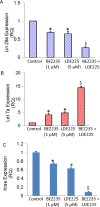PI3K/AKT/mTOR and sonic hedgehog pathways cooperate together to inhibit human pancreatic cancer stem cell characteristics and tumor growth
- PMID: 26451606
- PMCID: PMC4741658
- DOI: 10.18632/oncotarget.5055
PI3K/AKT/mTOR and sonic hedgehog pathways cooperate together to inhibit human pancreatic cancer stem cell characteristics and tumor growth
Abstract
Cancer stem cells (CSCs) play major roles in cancer initiation, progression, and metastasis. It is evident from growing reports that PI3K/Akt/mTOR and Sonic Hedgehog (Shh) signaling pathways are aberrantly reactivated in pancreatic CSCs. Here, we examined the efficacy of combining NVP-LDE-225 (PI3K/mTOR inhibitor) and NVP-BEZ-235 (Smoothened inhibitor) on pancreatic CSCs characteristics, microRNA regulatory network, and tumor growth. NVP-LDE-225 co-operated with NVP-BEZ-235 in inhibiting pancreatic CSC's characteristics and tumor growth in mice by acting at the level of Gli. Combination of NVP-LDE-225 and NVP-BEZ-235 inhibited self-renewal capacity of CSCs by suppressing the expression of pluripotency maintaining factors Nanog, Oct-4, Sox-2 and c-Myc, and transcription of Gli. NVP-LDE-225 co-operated with NVP-BEZ-235 to inhibit Lin28/Let7a/Kras axis in pancreatic CSCs. Furthermore, a superior interaction of these drugs was observed on spheroid formation by pancreatic CSCs isolated from Pankras/p53 mice. The combination of these drugs also showed superior effects on the expression of proteins involved in cell proliferation, survival and apoptosis. In addition, NVP-LDE-225 co-operated with NVP-BEZ-235 in inhibiting EMT through modulation of cadherin, vimentin and transcription factors Snail, Slug and Zeb1. In conclusion, these data suggest that the combined inhibition of PI3K/Akt/mTOR and Shh pathways may be beneficial for the treatment of pancreatic cancer.
Keywords: Gli; PI3K/AKT/mTOR; cancer stem cell; pancreatic cancer; sonic hedgehog.
Conflict of interest statement
All the authors of this article have declared “no conflict of interest”.
Figures













Similar articles
-
Inhibition of sonic hedgehog and PI3K/Akt/mTOR pathways cooperate in suppressing survival, self-renewal and tumorigenic potential of glioblastoma-initiating cells.Mol Cell Biochem. 2019 Apr;454(1-2):11-23. doi: 10.1007/s11010-018-3448-z. Epub 2018 Sep 24. Mol Cell Biochem. 2019. PMID: 30251117
-
Inhibition of pancreatic cancer stem cell characteristics by α-Mangostin: Molecular mechanisms involving Sonic hedgehog and Nanog.J Cell Mol Med. 2019 Apr;23(4):2719-2730. doi: 10.1111/jcmm.14178. Epub 2019 Feb 3. J Cell Mol Med. 2019. PMID: 30712329 Free PMC article.
-
GANT-61 inhibits pancreatic cancer stem cell growth in vitro and in NOD/SCID/IL2R gamma null mice xenograft.Cancer Lett. 2013 Mar 1;330(1):22-32. doi: 10.1016/j.canlet.2012.11.018. Epub 2012 Nov 28. Cancer Lett. 2013. PMID: 23200667 Free PMC article.
-
Targeting the phosphatidylinositol 3-kinase/Akt/mammalian target of rapamycin signaling network in cancer stem cells.Curr Med Chem. 2011;18(18):2715-26. doi: 10.2174/092986711796011201. Curr Med Chem. 2011. PMID: 21649579 Review.
-
PI3K/Akt/mTOR signaling pathway in cancer stem cells.Pathol Res Pract. 2022 Sep;237:154010. doi: 10.1016/j.prp.2022.154010. Epub 2022 Jul 3. Pathol Res Pract. 2022. PMID: 35843034 Review.
Cited by
-
Silencing of microRNA-135b inhibits invasion, migration, and stemness of CD24+CD44+ pancreatic cancer stem cells through JADE-1-dependent AKT/mTOR pathway.Cancer Cell Int. 2020 Apr 25;20:134. doi: 10.1186/s12935-020-01210-1. eCollection 2020. Cancer Cell Int. 2020. PMID: 32351328 Free PMC article.
-
Advances in Therapeutic Targeting of Cancer Stem Cells within the Tumor Microenvironment: An Updated Review.Cells. 2020 Aug 13;9(8):1896. doi: 10.3390/cells9081896. Cells. 2020. PMID: 32823711 Free PMC article. Review.
-
GLI3 knockdown decreases stemness, cell proliferation and invasion in oral squamous cell carcinoma.Int J Oncol. 2018 Dec;53(6):2458-2472. doi: 10.3892/ijo.2018.4572. Epub 2018 Sep 26. Int J Oncol. 2018. PMID: 30272273 Free PMC article.
-
Super-enhancers: novel target for pancreatic ductal adenocarcinoma.Oncotarget. 2019 Feb 22;10(16):1554-1571. doi: 10.18632/oncotarget.26704. eCollection 2019 Feb 22. Oncotarget. 2019. PMID: 30899425 Free PMC article.
-
The sonic hedgehog signaling pathway stimulates anaplastic thyroid cancer cell motility and invasiveness by activating Akt and c-Met.Oncotarget. 2016 Mar 1;7(9):10472-85. doi: 10.18632/oncotarget.7228. Oncotarget. 2016. PMID: 26859575 Free PMC article.
References
-
- Siegel R, Ma J, Zou Z, Jemal A. Cancer statistics, 2014. CA: a cancer journal for clinicians. 2014;64:9–29. - PubMed
-
- Adhikari AS, Agarwal N, Iwakuma T. Metastatic potential of tumor-initiating cells in solid tumors. Front Biosci. 2011;16:1927–1938. - PubMed
-
- Wang Z, Li Y, Ahmad A, Banerjee S, Azmi AS, Kong D, Sarkar FH. Pancreatic cancer: understanding and overcoming chemoresistance. Nature reviews Gastroenterology & hepatology. 2011;8:27–33. - PubMed
-
- Nusslein-Volhard C, Wieschaus E. Mutations affecting segment number and polarity in Drosophila. Nature. 1980;287:795–801. - PubMed
MeSH terms
Substances
Grants and funding
LinkOut - more resources
Full Text Sources
Other Literature Sources
Medical
Molecular Biology Databases
Research Materials
Miscellaneous

